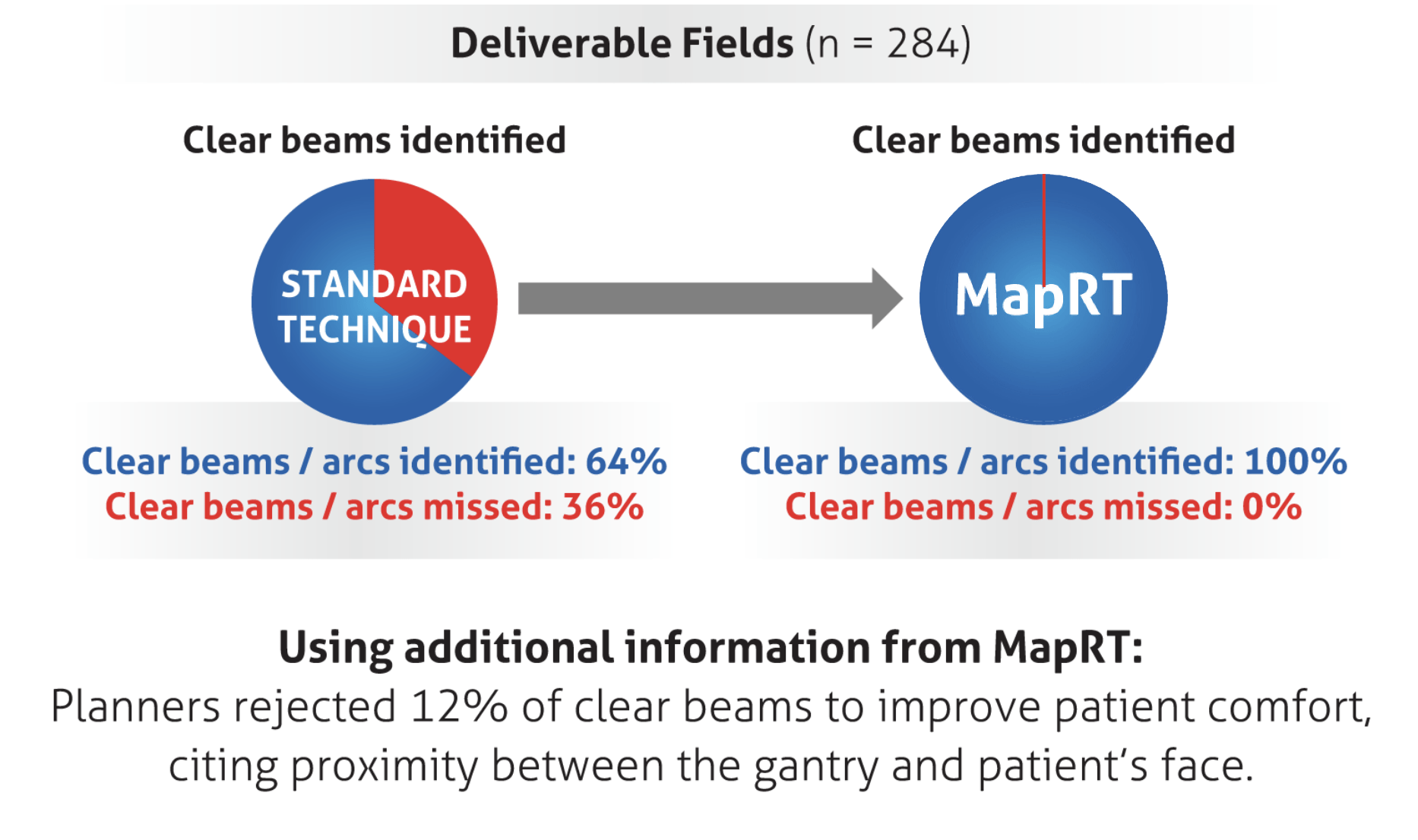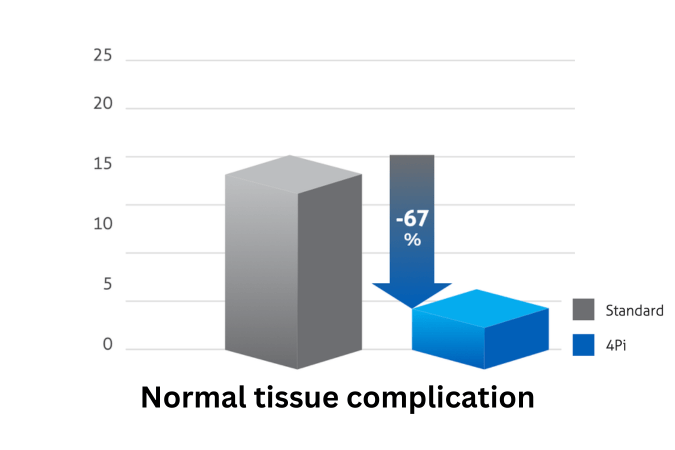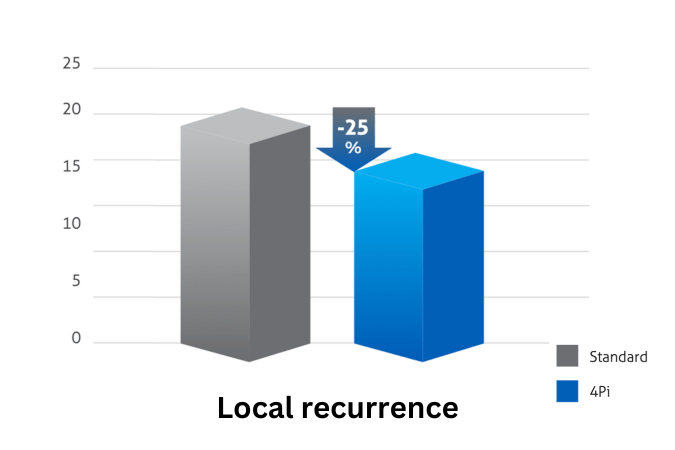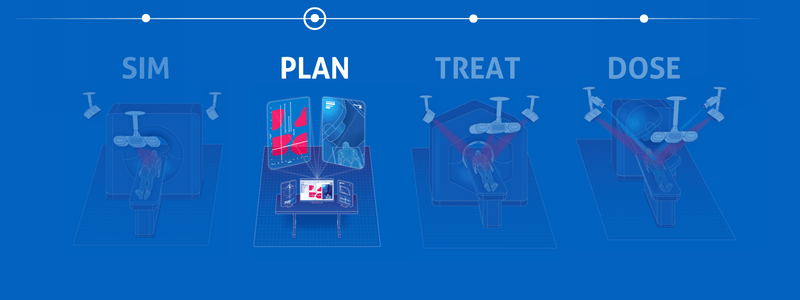
SGRT for Clearance Mapping
Recent studies show that non-coplanar treatments can deliver clinically relevant improvements to treatment plans1, specifically in lung cancer 2,3,4,5, breast cancer 6,7,8,9, head and neck cancer 10,11,12,13,14,15 , lymphoma 16,17, and high-grade glioma18 . Traditionally, non-coplanar treatments require extra planning and machine time, both for dry runs and treatments. Additionally, some non-coplanar plans are not deliverable, which can lead to complicated re-planning and repeat quality assurance work, leading to delays in patient treatment and increased costs.
MapRT is intended to make non-coplanar treatments fast, easy and safe. It uses SGRT to deliver a “clearance map”, which planners use to check which beams are deliverable during plan creation.
MapRT images the entire surface of the patient and accessories to detect collisions in the most frequent problem areas such as elbows. In addition, the clearance map checks safety for all couch and gantry angles, so planners have guidance to increase couch kicks and lengthen arcs – for better plans with confidence in delivery.
How MapRT works:


MapRT uses two lateral wide-field cameras in simulation to deliver a full 3D model of patients and accessories. This model is then used to calculate a clearance map for every couch (x-axis) and gantry (y-axis) angles. Plans can then be imported automatically to check beams, arcs, and the transition clearance.


MapRT can automatically receive and process DICOM RT plans from Eclipse®, Monaco®, Pinnacle®, and RayStation®.

“We see significant value in three areas: checking patient position at CT to ensure a robust setup and avoid unnecessary dose from scans in an unusable position; enhancing planning through increasing the range of beam options; improving the use of resources and the patient experience by avoiding dry runs and delays due to last minute replans.”
Helen Convery
Senior Dosimetrist (Development & Clinical Trials)
Improved assessment of deliverability
A five-center planning study 19 recently showed improved assessment of deliverability using MapRT:


Research shows:
The additional degrees of freedom are shown to increase the therapeutic ratio, either through dose escalation to the target or dose reduction to functionally important organs at risk, by multiple research groups. Although significant work is still needed to translate these new non-coplanar radiotherapy techniques into the clinic, clinical implementation should be prioritized.¹
Nine [lung cancer] studies were included and evaluated in the meta-analysis and treatment plans were designed with both coplanar beam arrangements CBA and non-coplanar beam arrangements (NCBA). After combining multicenter results, NCBA plans have significant advantages in reducing V20 of the whole lung and max dose of spinal cord [versus CBA].²
Non-coplanar VMAT proposed in this study showed more favorable plan quality than the coplanar VMAT plans for lung SABR with tumors located close to the heart.³
Static couch non-coplanar optimization yielded maximum dose reductions to OARs while maintaining target conformity for lung SBRT.⁴
For middle and lower lung tumors…a significant reduction in equivalent uniform dose, V30, V40 and V50 is observed for the heart when either non-coplanar fields or IMRT is used. IMRT also reduces the lung NTCP, V5, V13, V20 and V30 values and esophagus NTCP.⁵
[In left-sided breast cancer] Doses to the heart and ipsilateral lung were significantly lower with noncoplanar VMAT compared to both coplanar VMAT and 3D-CRT. Noncoplanar VMAT reduced doses to both the contralateral breast and lung compared to coplanar VMAT and achieved levels similar to 3D-CRT for the contralateral breast and moderately higher doses for the contralateral lung. Delivery of high doses (>30 Gy) to the contralateral side was completely avoided with noncoplanar VMAT, contrary to the results for coplanar VMAT and 3D-CRT.⁶
[In left-sided breast cancer] Compared to coplanar VMAT, non-coplanar VMAT provides improved conformity and homogeneity of whole P TVPTV, better dose sparing of the heart, bilateral lungs, left anterior descending coronary artery (LAD), and right breast for locoregional radiotherapy of left-sided breast cancer with IMN, potentially reducing the risk of normal tissue damage.⁷
[In this study of bilateral breast cancer cases] VMAT plans with noncoplanar beam arrangements had significant dosimetric advantages in terms of sparing of critical organs, that is Dmean of heart doses with almost equivalent lung doses and equally good target coverage.⁸
[For patients in our study of] postoperative stereotactic body radiotherapy (SBRT) in case of high-risk margins for pT1-T2/N0 oropharyngeal and oral cavity tumors … VMAT coplanar + noncoplanar had better dosimetric outcomes than VMAT coplanar and has become the standard technique for patients treated … in our institution. Acute toxicity appears acceptable.⁹
For the first 15 patients on a prospective phase II clinical trial exploring the safety, feasibility, and efficacy of the [noncoplanar] technique for recurrent head and neck cancer treatment. … statistically significant increases in dose conformity and mean PTV and GTV doses. With a median follow-up of 12 months … patient-reported QOL metrics were favorable. … treatment delivery was feasible, safe, and well-tolerated by patients. ¹⁰
The 7.4% rate of grade ≥3 late toxicity was comparable to the predicted 5.6% mean normal tissue complication probability for OARs, which was significantly reduced by 4π planning. ¹¹
The use of [noncoplanar] VMAT produced better target coverage and sparing of the shoulder and soft tissue of the neck as well as the critical organ compared with the [coplanar] VMAT in patients of head and neck malignancy. ¹²
Twenty-five previously treated patients of HNC underwent re-planning to improve the dose distributions with either coplanar VMAT technique … or noncoplanar … VMAT plans. [Noncoplanar] VMAT plans allowed to decrease the dose-volume-metrics for relevant OAR and results are reliable from a dosimetric standpoint. ¹³
[In treatment of nasopharyngeal tumours] VMAT using optimized noncoplanar irradiation trajectories reduced the mean and maximum doses in organs at risk compared to coplanar VMAT plans by 19% on average while the target coverage remains constant.¹⁴
VMAT provided significantly better target coverage, in terms of V100% (Volume encompassed by the isodose 100%), than IMRT, in particular when nc-VMAT was used. In general, organ at risk sparing is similar with the three approaches, although nc-VMAT can allow a statistically significant reduction of dose to contralateral parotid gland and cochlea.¹⁵
Overall there was a clear tendency towards higher plan quality with non-coplanar configurations. B-VMAT resulted in reduced low-dose spread in lungs and left breast. Non-coplanar beam configurations were favorable for young female mediastinal lymphoma patients, with patient-specific and plan-parameter-dependent dosimetric advantages.¹⁶
Non-coplanar IMRT had better PTV coverage and OARs sparing, except for being larger in V5 to breast and lung. In IMRT for young female patients with mediastinal lymphoma, using of non-coplanar IMRT significantly reduces the radiation dose to the breasts and lungs compared with coplanar IMRT, and consequently reduces the risk of breast second cancer and pulmonary toxicity. Besides young female patients, non-coplanar IMRT can also benefit other mediastinal lymphoma patients. ¹⁷
Mean and maximum organ at risk doses were equal or significantly lower (P < .05) with 4π than with VMAT. Particularly substantial dose reduction of 2.92 Gy in the average accumulated brainstem maximum dose enabled treatments that would otherwise not satisfy safe dose constraints with VMAT. One patient was not treated because neither plan met the dosimetric criteria. The other was treated with VMAT owing to comparable dosimetry resulting from a planning target volume located in a separate co-plane superior to organs at risk. Treatments were well tolerated, with an average patient comfort score of 8.6/10. Intrafractional motion was <1.5 mm for all delivered fractions, and the average delivery time was 34.1 minutes. ¹⁸
Non-coplanar treatment planning using clearance mapping has shown the potential to enhance outcomes, as shown in this planning study¹² of head and neck retreatments:
Calculated Outcome Probabilities Versus Coplanar VMAT


Would you like to find out more about MapRT?
At Vision RT, we pride ourselves on our responsiveness and customer service.
Whether you’re looking for a quote, a demo (virtual or in-person) or just more information, please get in touch about MapRT or any of our other suite of products:
MapRT is protected under various granted and pending patents including US Issued Patent 10,549,116 (Filed January 3rd, 2016)

